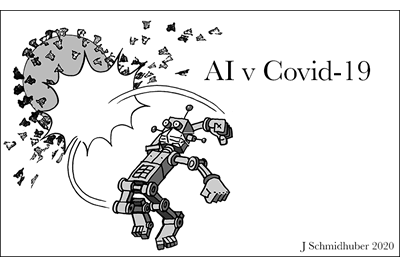Written by Jürgen Schmidhuber, Co-Founder and Chief Scientist, NNAISENSE and Scientific Director, Swiss AI Lab IDSIA and Professor of AI, USI and SUPSI, Switzerland
The coronavirus crisis has brought an unprecedented level of worldwide scientific collaboration. Artificial Intelligence (AI) based on Neural Networks (NNs) and Deep Learning [DL1] can help to fight Covid-19 in many ways.
The basic principle is simple. Teach NNs to detect patterns in data from viruses and patients and others. Use those NNs to predict future consequences of possible actions.
Act to minimize damage. Numerous examples were discussed at the recent ELLIS workshops on Machine Learning against the virus [EL1] [EL2]. (Disclaimer: I am an ELLIS Fellow.) Here are my very incomplete and subjective notes on various relevant approaches.

-
Track populations through pattern recognition [EL2]. Example: Peer-to-peer bluetooth apps on smartphones may prevent potentially dangerous contacts (not so much AI needed for that). More challenging: use deep NNs to recognise faces or gaits of persons and their contacts in videos. Detect mass behavior and predict outbreaks and other consequences to build early warning systems (compare Covid-19 forecasting challenge [KAG1]). This may be harder in countries with strict privacy laws [GEO] [DEC]. Identify groups at risk and predict results of therapies. Predict future demand for limited resources (ventilators, doctors) to optimize logistics [EL1]. Sequence virus genomes and detect their cities of origin [EL1]; predict where similar genomes will show up next. Build causal models of the spread of the disease [EL2]. Use NNs to obtain improved epidemiological models from data [DER].
-
Observe single patients. Teach NNs to monitor bio signals, heart rates (e.g., from smart watches), breathing [CHO], coughs [IMR] [EL2], other signals, e.g., [HYL]. Detect & predict asymptomatic cases in time. Analyze X-ray [MAG] [EL2] and other types of images; diagnose pathologies. (The first medical imaging contest won by NNs dates back to 2012 [MED] [TOP1] [GPUCNN5] when compute was almost 100 times more expensive than today.)
-
Partially automate drug design [EL1] and use AI to advance the field of immunology. Find molecules that dock on the (few) proteins of the simple virus to inhibit its activity (like antibodies). E.g., predict folding of proteins to find docking stations. Already 13 years ago when compute was almost 1000 times more expensive than today, Long Short-Term Memory (LSTM) excelled at protein folding prediction [HO1]. See also Google DeepMind's recent computational predictions of protein structures associated with Covid-19 [DMCO].
Teach NNs relevant chemistry and molecular biology. 1. Indirectly: use NN-based Natural Language Processing to mine scientific articles, e.g., [KAG2]. 2. Directly: Feedforward NNs or LSTM [DEC] [GAU] or Graph NNs (since 1995-96 [GOL] [KU]) can learn from examples to model chemical reactions: input ingredients plus conditions (temperature, catalyzers, etc) yield output molecules with certain properties. Then work the NN backwards: I want a substance that does this - which ingredients do I need? Then try the NN's suggestions in the real world. This may save lots of time & physical resources. NNs are sometimes good enough to replace wet lab tests (assays) [EL1]. NNs won the Merck Molecular Activity Challenge [JMA] [MER] and the Tox21 data challenge on predicting the toxicity of substances [TOX]. NNs can design new molecules [SEG] [GOM] and find the antibody needle in an antibody repertoire haystack [WID]. Ligand-based approach: given a molecule, an NN can predict to which proteins it will bind [UNT].
Typical drug discovery & development pipeline: 6+ years for selecting 5 out of 10'000 compounds, 7 years of clinical trials, 1+ years approval [EL1]. Speed this up by fast virtual screening: Use a large database such as ZINC which contains descriptions of 1 billion molecules. Pipe the data through a deep NN called SmilesLSTM [SMI] to suggest 30,000 top scoring molecules as SARS-CoV-2 inhibitors [HOF]. Test in the wet lab. Apply this approach also to drugs on the market, to reduce costly clinical trials. See the JEDI challenge of 9 April 2020: A billion molecules against Covid-19 [JEDI]. See [RCO] for many additional resources to help with Covid-19 research.
[The views expressed in this article are those of the author(s) and do not necessarily reflect the views of the UNCTAD secretariat]



